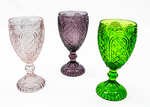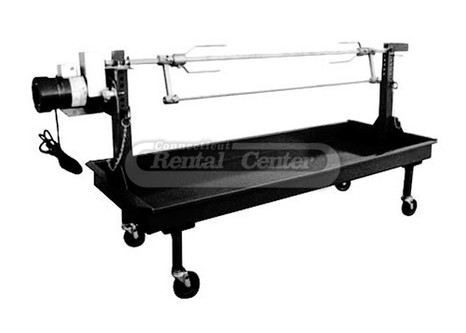2' x 5' Box
Weight 185 lbs.
Can roast a pig up to 125lbs
I. PLANNING YOUR PIG ROAST:
Determine the number of people that you plan to serve. Allow 1 1/2 lbs. of carcass weight per person. This will tell you the amount of pork to purchase. To estimate the cooking time, allow 1 hour per 10 pounds of pork.
Our rotisseriie will use about 30 lbs. of Charcoal to start the fire and and an additional 10 lbs of charcoal per hour during the cooking process will be used. NOTE: Do NOT use an automatic charcoal lighter or starter. We suggest the natural lump type of charcoal to be your best cooking source.
II. A GUIDELINE FOR PURCHASING:
- 75 lb Dressed Pig = approx. 30 lbs. cooked chopped pork = 50 guests
- 100 lb Dressed Pig = approx. 40 lbs. cooked chopped pork = 65 guests
- 125 lb Dressed Pig = approx. 50 lbs. cooked chopped pork = 85 guests
- 14 lbs uncooked shoulder = 10 lbs. cooked 6-7 hours = 10 guests
- 6-7 lbs. uncooked Boston Butt = 3 lbs. cooked 3 1/2 - 4 hours = 6 guests
- 14 lbs. uncooked ham = 6-7 lbs cooked 6-7 hours = 10-15 guests
III. PICKING YOUR PIG:
Purchase your pig from a state inspected establishment. Typically, a 7-day notice for a local super market, grocery store or meat packer is necessary to ensure that your pig is ready when you need it. Ask the butcher to remove the eyes and have the pig ready for roasting when you pick it up.
IV. Items that make the cook's life easier:
- Meat Thermometer to ensure 170º Internal Temperature
- " Burn Barrel" container to start coals in
- Container of water for possible heat source flare-up.
- Sturdy table for the "catch-all" items and final carving
- Knife or cleaver for chopping
- Chopping block
- Paper Towels
- Plenty of aluminum foil
- 2 pair of thick rubber gloves for handling pork - This is a 2 person job!
- Apron
- Container for sauce - allow 2 quarts of sauce per 75 pounds of pork.
- Chicken wire for tying pig to rotisserie spit.
- Extension cord with UL approval for outdoor use, grounded 3 prong plug
- Pliers for tightening wire during cooking process
V. PREPPING THE PIG & STUFFING INFORMATION:
Prepare the pig by washing it inside and out, giving particular attention to the ears, snout and feet. Place a block of wood between the jaws and thoroughly salt the inside of the cavity. If you wish to stuff the pig, now is the time to do it. Stuff the pig's cavity with whole Italian sausage links and whole, cleaned fryer chickens, bread stuffing, sauerkraut or whatever you feel like putting in there. Sew the cavity opening with butcher's string to keep the stuffing in place during the cooking process.
- Place a support bar clamp (dog bone) on the spit and tighten.
- Place a skewer on the spit and tighten
- Run the spit through the center of the pig, running the skewer into the pig.
- Place the second skewer on the spit and secure tightly against the pig.
- Place the support bar through the bottom of the dog bone clamp.
- Place the second dog bone clamp over the spit and support bar and secure
- Tie pig's feet to the bottom support bar.
- Carefully anchor all parts of the carcass to the spit by balancing and securing it with wires or chicken wire. This will require 2 strong people!
- Since the back and loin area cook most rapidly, the pig must be secured in such a way that it will not flop about and break as it approaches doneness. Tie the legs to the support bar and cover the tail and ears with foil to prevent charring. The rate of cooking can be adjusted somewhat by varying the fire - hotter in the ham and shoulder and medium in the loin.
VI. PREPARING THE FIRE:
The fire (charcoal briquettes) should not be directly below the spit. We suggest 30 lbs. of charcoal to start. Do not use the self starting type of charcoal. Arrange the charcoal the length of the pig in two rows, about 12 - 15 inches apart. Either position a drip pan or lay a mound of sand directly under the pig to catch the grease dripping from the pig. Fat dripping in to the fire can cause a burst of flame that could char the outside of the pig. You will need to add approximately 10 pounds of charcoal per hour of cooking time. It will help if you have a separate barrel or can to start the charcoal in so you are only adding lit charcoals to the pit.
VII. LOADING THE ROTISSERIE:
- Make sure the rotisserie is NOT plugged in.
- Set the mounted pig on the rotisserie frame
- Attach the rotisserie drive chain and securely tighten the chain by adjusting the motor and tightening the knob.
- Place the chain guard over the drive chain.
- Plug the motor into a UL approved, outdoor extension cord or outlet.
- Turn motor on and remove hot coal covers to begin cooking.
VIII. SAFETY WARNINGS:
To prevent serious injury, the chain guard must be in place. Do NOT operate these units without the safety guard in place!
Electric motor must be plugged into a ground fault protected outlet and if and extension cord is necessary, it must be a 3-prong, grounded UL approved for outdoor use extension cord.
Rotisseries generate extreme heat and are mechanical devices. Keep children away at all times.
IX. COOKING THE PIG:
Do not exceed 225º F cooking temperature for the first two hours of cooking. Allow 1 hour of cooking time per 10 pounds of pork. An internal temperature of 170º must be reached. Have additional coals started outside the grill, ready to be added as needed, to maintain the proper temperature.
As the pig roasts, it will shrink, so have tools handy to tighten the wires or chicken wire. It is also important to fill a plastic bottle or sprinkler with water to put out any flare-ups among the coals. Flare-ups are more frequent during the first few hours of roasting, so this is when the most attention is required. Basting the hog is optional.
X. COMING DOWN THE HOME STRETCH:
As the pig nears doneness, place a meat thermometer, or two of them to be certain, in the center of the "Ham" of the pig, making sure not to rest the thermometer against any bone or spit rod. When the thermometer registers 165º -170º, your pig is ready to transfer to the carving area. Let the pig rest for 20 minutes before carving.
XI. LET THE PARTY BEGIN:
Have a large surface available for carving such as an old card table or a heavy board, well covered with heavy aluminum foil. The meat should literally fall off the bones, relieving you of a lot of carving.
Slice and chop the meat and serve with barbecue sauce,
If you need more information or are looking for other Grills rentals like this, contact Connecticut Rental Center or view our other Grills.

















